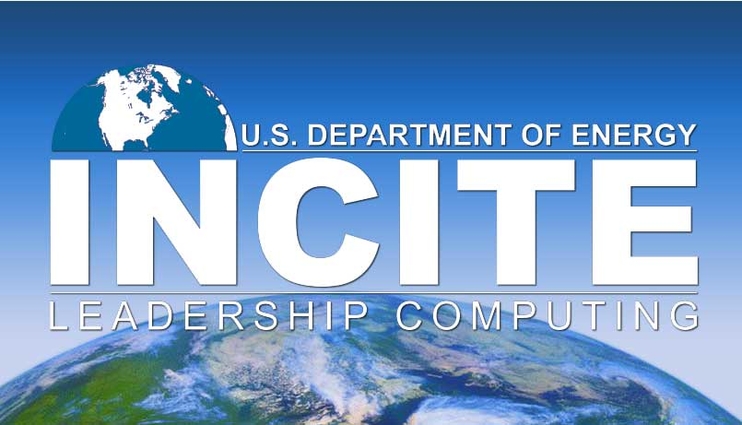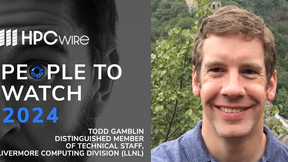Lab researchers awarded time on top computers to advance science
 (Download Image)
Eight Lawrence Livermore researchers have been awarded nearly 800 million core hours on two of America’s fastest supercomputers dedicated to open science: Mira, an IBM Blue Gene/Q system located at Argonne National Laboratory, and Titan, a Cray XK7 system located at Oak Ridge National Laboratory. This award is through the Department of Energy’s Innovative and Novel Computational Impact on Theory and Experiment (INCITE) program.
(Download Image)
Eight Lawrence Livermore researchers have been awarded nearly 800 million core hours on two of America’s fastest supercomputers dedicated to open science: Mira, an IBM Blue Gene/Q system located at Argonne National Laboratory, and Titan, a Cray XK7 system located at Oak Ridge National Laboratory. This award is through the Department of Energy’s Innovative and Novel Computational Impact on Theory and Experiment (INCITE) program.
As part of the Department of Energy’s Innovative and Novel Computational Impact on Theory and Experiment (INCITE) program, eight Lawrence Livermore National Laboratory (LLNL) researchers have been awarded nearly 800 million core hours on two of America’s fastest supercomputers dedicated to open science – Mira, an IBM Blue Gene/Q system located at Argonne National Laboratory (ANL), and Titan, a Cray XK7 system located at Oak Ridge National Laboratory (ORNL).
Open to researchers from academia, government labs and industry, the INCITE program is the major means by which the scientific community gains access to some of the fastest supercomputers. The program aims to accelerate scientific discoveries and technological innovations by awarding, on a competitive basis, time on supercomputers to researchers with large-scale, computationally intensive projects that address grand challenges in science and engineering. This year, nearly 6 billion core hours were awarded to 56 projects.
The LLNL recipients:
David Bader: 190 million core hours for "Accelerated Climate Modeling for Energy" – The Accelerated Climate Modeling for Energy (ACME) project seeks to develop the simulation capability needed to answer "grand challenge" science questions. Two of these science questions — concerning the water cycle and cryosphere systems — will be pursued in the first three years of the project while researchers also seek to quantify the benefits of high resolution on the simulated climate. Through ACME, researchers can assist the U.S. Department of Energy in preparing for the coming paradigm shift to exascale computing.
The team includes co-investigators from Sandia National Laboratories (SNL), ORNL, Lawrence Berkeley National Laboratory (LBNL), ANL, Los Alamos National Laboratory (LANL) and Pacific Northwest National Laboratory (PNNL).
Nicolas Schunck: 204 million core hours for "Nuclear Structure and Nuclear Reactions" – Predictions for the structures and reactions of nuclei, with assessed uncertainties, are important for the future of U.S. energy and security needs. The development of a robust and precise nuclear theory, based on the underlying theory of the standard model of elementary particles, incorporating both the strong and electroweak sectors, represents a "holy grail" for physics, with many applications in both basic science and applied science. However, developing a comprehensive description of all nuclei and their reactions requires investigations of exotic isotopes that are difficult or impossible to study experimentally. For this multiyear INCITE project, researchers will continue to use DOE supercomputers to provide needed predictions where direct experiments are not possible or are subject to large uncertainties.
The team includes co-investigators from Iowa State University, LANL, ORNL, TRIUMF, University of Tennessee-Knoxville and ANL.
Frederico Fiuza (principal investigator), Bruce Cohen and Dmitri Ryutov: 110 million core hours for "Particle Acceleration in Shocks: From Astrophysics to Laboratory in Silico" – Particle acceleration in astrophysical shocks is believed to be one of the most important sources of energetic cosmic rays. This project aims to answer two important science questions recently highlighted by the U.S. National Academy of Sciences: What are the acceleration mechanisms for cosmic rays? Can we generate relativistic shocks in the laboratory and mimic these extreme cosmic accelerators? Computational modeling is critical in addressing these questions to gain an understanding of the physical mechanisms behind shock formation and particle acceleration and to establish the conditions whereby these shockwaves can be excited in the laboratory and explored for different applications. These efforts will trigger unique scientific results and open new avenues for research on the fundamental processes associated with shock formation, propagation and particle acceleration, enabling reproduction in the laboratory of conditions found in gamma-ray bursts, supernovae and other extreme astrophysical events.
The team includes co-investigators from the University of California, Los Angeles, and Portugal’s Instituto Superior Técnico.
Todd Gamblin and Bronis de Supinkski: 90 million core hours for "Performance Evaluation and Analysis Consortium (PEAC) End Station" – This project focuses on a series of goals that will provide the performance research community with tools, run times and methodologies to enable scientists to further understand leadership-class systems and how to use each system most efficiently.
The team includes co-investigators from LBNL, ANL, San Diego Supercomputer Center, the University of California, Berkeley, the University of Tennessee-Knoxville, ORNL, the University of Illinois at Urbana-Champaign, the University of Utah, the University of Maryland, PNNL, the University of Southern California’s Information Sciences Institute, the University of Oregon, Rice University and the University of Wisconsin-Madison.
Miguel Morales: 185 million core hours for "QMC Simulations Database for Predictive Theory and Modeling" – The project will involve quantum Monte Carlo (QMC) studies in heterogeneous catalysis of transition metal nanoparticles, phase transitions, properties of materials under pressure and strongly correlated materials. These research directions share a common need for predictive simulations where the relevant energy scales are small enough to be beyond the reach of other methods. The project will produce direct answers to fundamental materials science questions and establish benchmark levels of accuracy that will provide targets for future developments in related electronic structure approaches.
The team includes co-investigators from the University of Illinois at Urbana-Champaign, Purdue University, the University of California, Berkeley, ORNL and SNL.
Contact
 Breanna Bishop
Breanna Bishop
[email protected]
(925) 423-9802
Related Links
MiraTitan
INCITE
2015 Awards
Tags
HPC, Simulation, and Data ScienceSupercomputing
Computing
Science
Featured Articles







